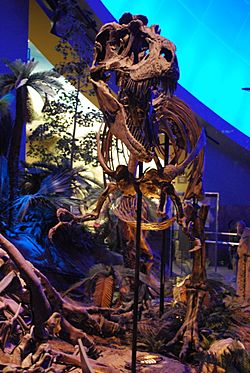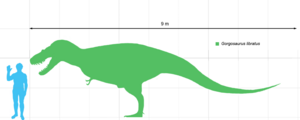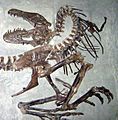Gorgosaurus facts for kids
Quick facts for kids GorgosaurusTemporal range: Upper Cretaceous
|
|
|---|---|
 |
|
| Gorgosaurus skeletal mount | |
| Scientific classification | |
| Kingdom: | |
| Phylum: | |
| Class: | |
| Superorder: | |
| Order: | |
| Suborder: | |
| Family: | |
| Genus: |
†Gorgosaurus
Lambe, 1914
|
| Species | |
|
|
Gorgosaurus means "fierce lizard". It was a type of theropod dinosaur in the tyrannosaurid family. This amazing creature lived in western North America a very long time ago. It roamed the Earth between 80 and 73 million years ago. This was during the Late Cretaceous Period.
Like its famous relatives, Gorgosaurus was a large predator. It walked on two legs, meaning it was bipedal. It had many big, sharp teeth for hunting. It also had tiny front limbs with two fingers, just like other tyrannosaurids. Even though Gorgosaurus was big for a theropod, it was smaller than the more famous Tyrannosaurus.
Paleontologist Lawrence Morris Lambe first described Gorgosaurus in 1914. Since then, scientists have found over 20 Gorgosaurus skeletons. This makes it one of the most common tyrannosaurids found in the fossil record. In some places, it lived alongside another tyrannosaurid called Daspletosaurus. They likely hunted different things to avoid competing. As an apex predator, Gorgosaurus was at the top of the food chain. It probably hunted large dinosaurs like the ceratopsid Centrosaurus and the hadrosaur Hypacrosaurus.
Contents
What Gorgosaurus Looked Like
Gorgosaurus was a large and scary animal. But it was much smaller than huge tyrannosaurids like Tarbosaurus and Tyrannosaurus. It was also built more lightly than Daspletosaurus. Adult Gorgosaurus could grow to be 7 to 8 metres (about 27 to 30 feet) long. This is from its snout to its tail. Scientists think it weighed around 2.5 tonnes (about 2.75 short tons).
It had a huge skull that was almost a meter (39 inches) long. This heavy head sat on a short, S-shaped neck. The skull had large openings called fenestrae. These holes made the head lighter. They also provided space for muscles and sensory organs. Gorgosaurus had more circular eye sockets than other tyrannosaurids. It had big, curved teeth, tiny two-fingered front arms, and strong legs. Gorgosaurus looks very similar to its close relative, Albertosaurus.
How Gorgosaurus is Classified
Gorgosaurus belongs to the family Tyrannosauridae. This group of dinosaurs is part of the theropod order. It is in a smaller group called Albertosaurinae. Its closest relative is Albertosaurus sarcophagus, which lived a little later. These two species are the only ones officially named in the Albertosaurinae group. But there might be other types that haven't been described yet.
In 1970, a scientist named Russell moved G. libratus (the only known species of Gorgosaurus) into the Albertosaurus group. Many other scientists agreed with him. However, more recent studies by Thomas Holtz show that G. libratus is different enough from other Albertosaurus species. This means it should keep its original name, Gorgosaurus.
Another dinosaur, Appalachiosaurus, was once thought to be an albertosaurine. But newer research suggests it is just outside the Tyrannosauridae family.
The other main group of tyrannosaurids is called Tyrannosaurinae. This group includes famous dinosaurs like Daspletosaurus torosus, Tarbosaurus bataar, and Tyrannosaurus rex. Compared to these strong tyrannosaurines, albertosaurines like Gorgosaurus were more slender. They had smaller skulls and longer bones in their lower legs and feet.
Discovery and Naming of Gorgosaurus
Paleontologist Lawrence Moe first described Gorgosaurus in 1914. He named it "fierce lizard." This name comes from the Greek words gorgos, meaning "terrible" or "fierce," and saurus, meaning "lizard."
Fossilized tyrannosaurid teeth were found in Montana in 1856. They were described as Deinodon by Joseph Leidy. These teeth likely belonged to Gorgosaurus. However, it's very hard to tell different tyrannosaurid species apart just from their teeth. So, Deinodon is now considered a nomen dubium, which means its name is doubtful.
Gorgosaurus is known from more complete fossils than any other tyrannosaurid. Over 20 skeletons have been found! Most confirmed fossils come from the upper Dinosaur Park Formation in Alberta, Canada. This area dates back to the late Campanian age. Scientists have also found possible pieces of Gorgosaurus in other places. These include the Two Medicine Formation and Judith River Formation in Montana. They have also been found in the Fruitland Formation and lower Kirtland Formation in New Mexico.
Images for kids
-
Type specimen of Gorgosaurus sternbergi (AMNH 5664), now recognized as a juvenile Gorgosaurus libratus
-
Specimen USNM 12814 (formerly AMNH 5428)
-
Skeletal mount, Children's Museum of Indianapolis
-
Bob Bakker and a skeleton with several bone injuries, from the "Dinosaur Mummy: CSI" exhibit at the HMNS
-
Sub-adult specimen TMP91.36.500 in "death pose", Royal Tyrrell Museum of Palaeontology
-
Cast of specimen ROM 1247
-
Dinosaur Park specimen (FMNH PR308) of Daspletosaurus, mounted at the Field Museum
See also
 In Spanish: Gorgosaurus libratus para niños
In Spanish: Gorgosaurus libratus para niños













